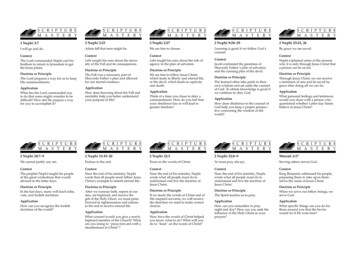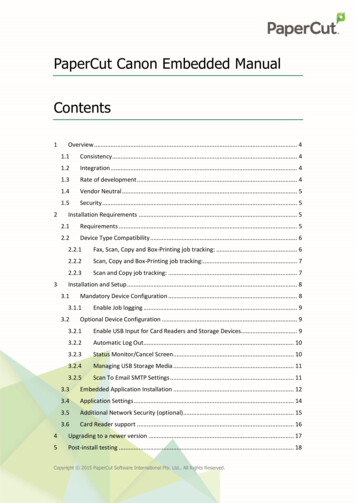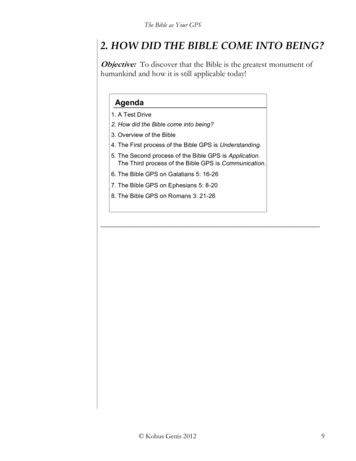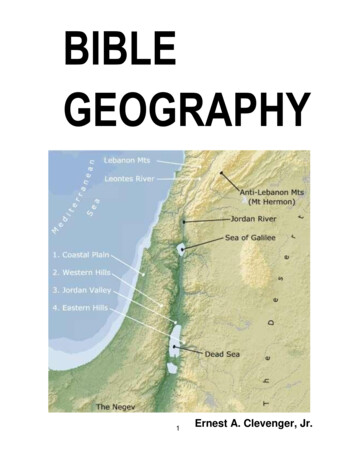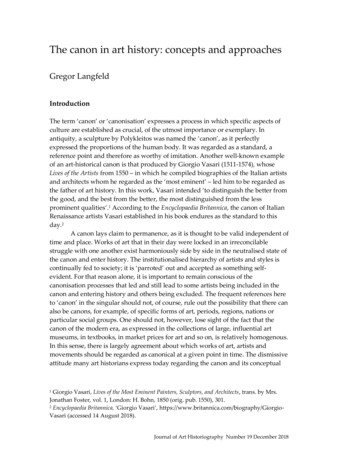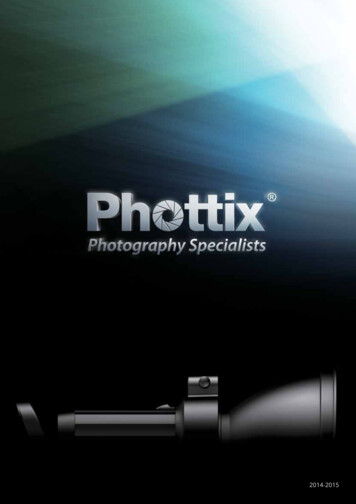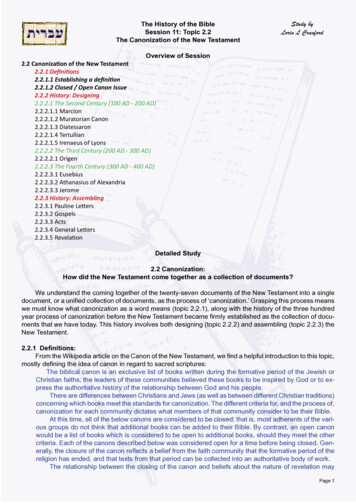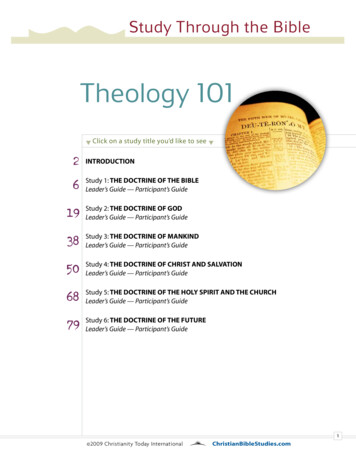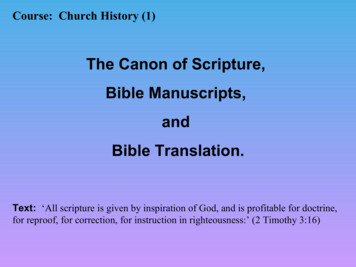
Transcription
Course: Church History (1)The Canon of Scripture,Bible Manuscripts,andBible Translation.Text: ‘All scripture is given by inspiration of God, and is profitable for doctrine,for reproof, for correction, for instruction in righteousness:’ (2 Timothy 3:16)
Evidence supporting the Canon of ScriptureEvidence from subjective experienceThe greatest evidence that the Bible is God’s Word is the evidence of personalexperience.Those who have experienced salvation know that the Bible is the Word of God.Subjective experience is confirmed by many othersPersonal experience is confirmed by the testimony of multitudes throughoutChurch history.Criteria for the Canon of Scripture (objective evidence)The writings of the New Testament have been upheld as scripture since the timeof the Early Church. The Canon of Scripture was based upon strict criteriaregarding who wrote it, the message of the book and acceptance by churchleaders.
The Canon of ScriptureWhy was the New Testament written?Luke – it seemed a good idea (Luke 1:3).Epistles written to build up the believers and leaders (Pastoral epistles).Paul wrote his epistle to Philemon concerning a runaway slave who he led to theLord in Rome.Scripture is written out of experienceNew Testament scripture is the inspired word of God expressed through theexperiences of the Apostles.Scripture can never be separated from experience.Doctrine without experience is deadExperience that is not built upon doctrine is empty.
How is the New Testament the inspired word of God?Scripture is inspired by the Holy Spirit (theopneustos - God breathed)‘All scripture is given by inspiration of God, and is profitable for doctrine, forreproof, for correction, for instruction in righteousness:’ (2 Timothy 3:16)In what way is scripture inspired?The Roman Catholic Council of Trent says:Scripture was dictated by God.
COUNCIL OF TRENTSESSION THE FOURTHCelebrated on the eighth day of the month of April, in the year MDXLVI. (1546)DECREE CONCERNING THE CANONICAL SCRIPTURESThe sacred and holy, ecumenical, and general Synod of Trent,--lawfullyassembled in the Holy Ghost, the Same three legates of the Apostolic Secpresiding therein,--keeping this always in view, that, errors being removed, thepurity itself of the Gospel be preserved in the Church; which (Gospel), beforepromised through the prophets in the holy Scriptures, our Lord Jesus Christ, theSon of God, first promulgated with His own mouth, and then commanded to bepreached by His Apostles to every creature, as the fountain of all, both savingtruth, and moral discipline; and seeing clearly that this truth and discipline arecontained in the written books, and the unwritten traditions which, receivedby the Apostles from the mouth of Christ himself, or from the Apostlesthemselves, the Holy Ghost dictating, have come down even unto us,transmitted as it were from hand to hand;
Was scripture dictated by the Holy Spirit?The style in which scripture is written shows that it could not be dictated by theHoly Spirit.Dictation only uses another persons intellect to take down information.Scripture is not written like that.The epistles of Paul express the mind of Paul and are sent to people for a specificpurpose.The Holy Spirit moved upon the intellect of the writer but the writer isexpressing his own thoughts.
Lesson Outline1. The Canon of ScriptureCase Study: DidacheDevelopment of the New Testament Canon2.Bible ManuscriptsPapyrusParchment3.Bible TranslationTranslated to Latin – JeromeTranslated from Latin – WycliffeTranslated from Greek – Luther, Wycliffe, King James Bible
1. The Canon of New Testament ScriptureThe Holy Spirit did not say there are only 27 books in the New Testament.What would happen if Paul’s Epistle to the Laodiceans was found?(Colossians 4:16)How did the 27 books of the New Testament come to be accepted by the Church?Why do we reject other writings such as the Didache from being Scripture?Criteria for accepting writings as scriptureWas it written by an Apostle or someone associated closely with an Apostle?Was the message consistent with scripture?Was it widely accepted by church leaders as scripture?
Case Study: Why is the The Didache not regarded as scripture?Didache – The Teaching of the Twelve ApostlesPocket version of the Didache4th century copy.Part of the find at Oxyrynchus, Egypt (1896-7)Kept in the Sackler Library in Oxford.Didache 3.1-2Didache 1.3Didache 1.4Didache 2.7-3.1
Didache – The Teaching of the Twelve ApostlesWho wrote the Didache? UnknownWhen was it written? Exact date unknown - 1st or 2nd century. (50AD – 160AD)Where was it written? Possibly Egypt.What is the Message?Three sections1. The Two Ways – the way of life and the way of death2. Rituals – baptism, fastings and holy communion3. The ministryConcluding chapter is apocalyptic (Chapter 16)
The Teaching of the Twelve Apostles,Commonly Called the Didache‘Now about baptism: this is how to baptize. Give public instruction on all thesepoints, and then "baptize" in running water, "in the name of the Father and of theSon and of the Holy Spirit."‘If you do not have running water, baptize in some other.‘If you cannot in cold, then in warm. If you have neither, then pour water on thehead three times "in the name of the Father, Son, and Holy Spirit."‘Before the baptism, moreover, the one who baptizes and the one being baptizedmust fast, and any others who can. And you must tell the one being baptized tofast for one or two days beforehand.’
Has it been accepted as scripture by church leaders?Eusebius lists the Didache among the spurious books."Let there be placed among the spurious works the Acts of Paul, the so-calledShepherd and the Apocalypse of Peter, and besides these the Epistle ofBarnabas, and what are called the Teachings of the Apostles, and also theApocalypse of John, if this be thought proper; for as I wrote before, some rejectit, and others place it in the canon.”(Historia Ecclesiastica III, 25):Authorship – not associated with the Apostles.Message – not consistent with scriptureAcceptance – not accepted by Early Church as scripture.Conclusion: Didache is not to be regarded as scripture but interesting forthe study of church history.
What about the Revelation (Apocalypse) of John?Who wrote it: The Apostle JohnWhen? About 90ADWhat is the Message? Revelation of Jesus.Why should it be regarded as scripture?Author is John the ApostleMessage is consistent with the rest of scripture.Widely accepted by church leaders as authentic.Eusebius places it with the spurious books but acknowledges that many accept it ascanonical.
Development of the Canon of Scripture Peter recognised the writings of Paul to be scripture. Marcion – Gnostic Canon (c.150) The Muratorian Canon (c.170) Ireneaus (c.180) Tertullian (wrote between 196-212) Papias (2nd century) Quoted by Eusebius (c.263-c.339) Athaniasias (367) Council of Carthage (397)
The Apostle Peter recognised Paul’s Epistles as ScriptureThe Second Epistle of Peter affirms that the epistles of Paul were recognised asScripture in the days of the Apostles. Although the New Testament canon was notfirmly fixed until the 4th century the writings of the Apostles were recognised asscripture from the time they were written.‘ even as our beloved brother Paul also according to the wisdom given unto himhath written unto you; As also in all his epistles, speaking in them of these things;in which are some things hard to be understood, which they that are unlearned andunstable wrest, as they do also the other scriptures, unto their own destruction.’ (2Peter 3:14b-15)
Marcion’s Canon (c.150)Marcion (c.80-160)First canon made by the heretic Marcion.Formed his own canon of scripture to support his doctrine.He rejected the Old Testament and regarded the god of the Old Testament as evil.Marcion's canon (c.150) Luke's gospel (with Old Testament quotes removed that linked Jesus with theOld Testament 10 letters of Paul but with the removal of Old Testament quotations.He called Ephesians – the Epistle to the Laodiceans(He did not accept Hebrews or I & II Timothy and Titus)Marcion’s canon forced church to form a canon of scripture
The Muratorian Canon (possibly from c.170)Discovered by Ludovico Antonio Muratori in 1740 in the Ambrosian Library inMilanCodex copied c. 7th or 8th century - lists all books of New Testament.Original list from which this was copied is dated as early as 2nd century butsome say it is 4th century.Beginning and ending of the parchment is missing.Starts with the words the third book of the gospel is that according to Luke.
Ireneaus (c. 180)Four Gospels (Matthew, Mark, Luke and John)Maintained that there could only be four Gospels as there are four principal windsand four zones of the earth.P45 Papyrus shows that the Four Gospels and Acts were read together (200250AD)Tertullian (wrote between 196 – 212)He was the first to refer to the Old and New Testament (Against Marcion Book 4Chapter 6).Tertullian became a Montanist c.206.Tertullian says that Marcion mutilated the New Testament and Valentinusmisinterpreted it.Tertullian does not quote a list of books accepted as scriptures but he upholds thefollowing books as scripture: Four gospels, Acts, 13 epistles of Paul, 1 Peter, 1John, Jude and Revelation.
Papias (2nd century)Bishop of Hierapolis in Phrygis c.125.Quoted by the historian Eusebius (c.263 – c.339).Mentions many of the New Testament booksAthanasius (367)First listed the 27 books of New Testament (Festal Letter 39)Council of Carthage (397)Accepted the 27 books of New Testament as scripture.
Summary:Paul’s Epistles were recognised as scripture even during the days of the Apostles.Three criteria of scripture:1. Written by an Apostle or one closely associated with an Apostle.2. Message consistent with the doctrine of the Apostle’s.3. Accepted as scripture by the Church?The leaders of the Early Church did not see a need for a Canon of Scripture untilMarcion adapted a Gnostic Canon of Scripture.The writings of Church leaders show that most New Testament books wereaccepted as scripture in the 2nd and 3rd centuries.The Council of Carthage in 397 recognised the books that were already accepted asscripture.
Development of the New Testament Canon 2. Bible Manuscripts Papyrus Parchment 3. Bible Translation Translated to Latin – Jerome Translated from Latin – Wycliffe Translated from Greek – Luther, Wycliffe, King James Bible.
